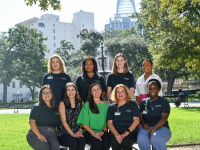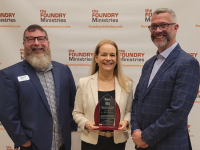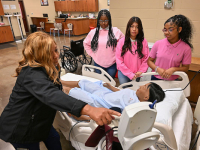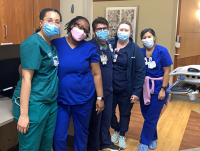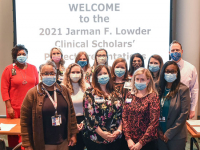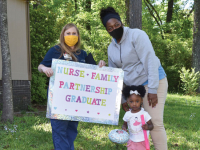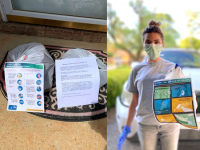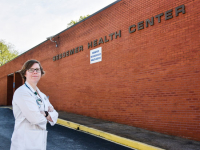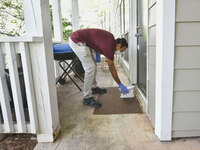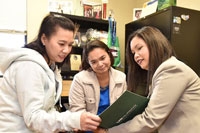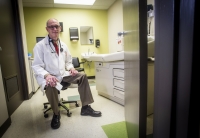 The University of Alabama at Birmingham School of Nursing PATH (Providing Access to Healthcare) and HRTSA (Heart FailuRe Transitional Care Services for Adults) Clinics have jointly received the 2020 Creativity in Practice and Education Award from the National Academies of Practice.
The University of Alabama at Birmingham School of Nursing PATH (Providing Access to Healthcare) and HRTSA (Heart FailuRe Transitional Care Services for Adults) Clinics have jointly received the 2020 Creativity in Practice and Education Award from the National Academies of Practice.
NAP is a nonprofit organization founded in 1981 to advise governmental bodies on the country's health care system. Distinguished practitioners and scholars are elected annually by their peers from 14 health professions to join NAP, the only interprofessional group of health care practitioners and scholars dedicated to supporting affordable, accessible, coordinated quality health care for all.
The Creativity in Practice and Education Award from NAP recognizes a person and/or team who display creative solutions in interprofessional education and/or interprofessional practice, thereby achieving improvements in health care.
The PATH and HRTSA Clinics created and sustain an interprofessional collaborative practice model called STAND-UP, which stands for Smooth Care Transitions for Diverse and Underserved Populations. The STAND-UP model and the knowledge dissemination associated with the model exemplify the integration of interprofessional education and interprofessional collaborative practice for chronic disease management of vulnerable populations.
These clinics are part of the UAB Nursing Partnership, an academic-practice partnership of the UAB School of Nursing and UAB Health System.
 “It is an honor to receive this award and to have our work in building and sustaining the nurse-managed clinics recognized nationally,” said Associate Dean for Clinical and Global Partnerships and Jane H. Brock Florence Nightingale Endowed Professor of Nursing Maria Shirey, PhD, MBA, RN, NEA-BC, ANEF, FACHE, FNAP, FAAN. “The clinics serve as a medical home for patients to receive ongoing primary, specialty and transitional care helping maintain optimal health outcomes and minimizing unnecessary emergency department visits and hospitalizations.”
“It is an honor to receive this award and to have our work in building and sustaining the nurse-managed clinics recognized nationally,” said Associate Dean for Clinical and Global Partnerships and Jane H. Brock Florence Nightingale Endowed Professor of Nursing Maria Shirey, PhD, MBA, RN, NEA-BC, ANEF, FACHE, FNAP, FAAN. “The clinics serve as a medical home for patients to receive ongoing primary, specialty and transitional care helping maintain optimal health outcomes and minimizing unnecessary emergency department visits and hospitalizations.”
The Heart FailuRe Transitional Care Services for Adults (HRTSA) Clinic is a nurse-managed interprofessional collaborative clinic for underserved patients with a diagnosis of heart failure. It provides guideline directed care and education to patients and their caregivers across the care continuum by seeing patients in the hospital, clinic and home. The interprofessional team of providers includes nurse practitioners, clinical nurse leaders, social workers, registered nurses, patient care technicians, collaborating physicians, behavioral health integration services, pharmacists, health professions and public health. The clinic also provides opportunities for students from a variety of disciplines to learn in an innovative interprofessional model of care.
 The nurse-managed Providing Access to Healthcare (PATH) Clinic utilizes an interprofessional, team-based model to provide diabetes care to an uninsured, medically underserved population discharged from UAB Hospital. Services provided include nurse practitioner visits, physician visits, optometry, nutrition, mental health, physical therapy, behavioral health integration services and assistance in obtaining needed medications and diabetes testing supplies at the lowest possible cost. This clinic also provides opportunities for students from a variety of disciplines to learn in an innovative interprofessional model of care.
The nurse-managed Providing Access to Healthcare (PATH) Clinic utilizes an interprofessional, team-based model to provide diabetes care to an uninsured, medically underserved population discharged from UAB Hospital. Services provided include nurse practitioner visits, physician visits, optometry, nutrition, mental health, physical therapy, behavioral health integration services and assistance in obtaining needed medications and diabetes testing supplies at the lowest possible cost. This clinic also provides opportunities for students from a variety of disciplines to learn in an innovative interprofessional model of care.
“The use of interprofessional collaborative practice models maximize the unique contributions of multiple disciplines ultimately to benefit those we serve,” Shirey noted. “Gaining experience in such models during student clinical rotations allows future healthcare professionals to actively engage the talents of others and learn to enhance teamwork.”
When the UAB School of Nursing first opened the PATH Clinic in 2011, its goal was to help patients with no health insurance, many of whom were homeless, without access to health care. Less than 10 years and two clinics later, the STAND-UP model that developed as a result has helped more than 2,000 people in Alabama receive ongoing primary, specialty and transitional diabetes and heart failure care for which previously they might have used an emergency room or gone without.
“We continue to evaluate and grow our STAND-UP model on an ongoing basis with a spirit of continuing quality improvement,” Shirey said. “To this end, we have integrated telehealth services to expand our reach and continue our efforts toward sustainability and scalability of our model. We are committed to sharing our experiences through ongoing dissemination of our efforts and related outcomes.”

